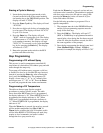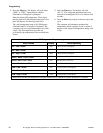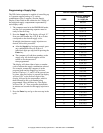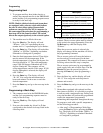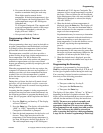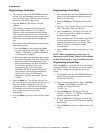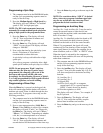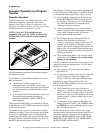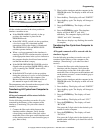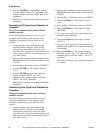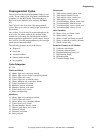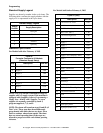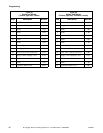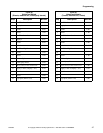
Programming
F232090
40
© Copyright, Alliance Laundry Systems LLC – DO NOT COPY or TRANSMIT
Simulator Operation and Program
Transfer
Simulator Operation
The WE-6 simulator is an optional accessory to the
WE-6 microcomputer-controlled UWP washer-
extractor. See Figure 8. When the simulator is first
energized, the simulator display will show the program
(ROM) identification code for five seconds.
NOTE: Cycles for UWP machines are not
compatible with cycles for UWPV machines. DO
NOT transfer cycles from one of these models to
another.
All programming instructions in this manual apply to
the simulator as well.
The simulator is a hand-held unit which serves more
than one purpose:
● The simulator’s primary purpose is to
preprogram cycles for transfer to the washer-
extractor and to transfer program cycles between
the washer-extractor and the simulator in either
direction.
● As an instructional aid, the simulator can be used
for teaching programming techniques to
individuals unfamiliar with the UWP WE-6
microcomputer.
The keypad and LED display are mounted on the top
of the simulator. The ON/OFF rocker switch is located
on the front end-panel.
The handle pivots to serve as a stand when using the
simulator on a table. To pivot the handles, grasp them
at the point of attachment to the main housing and
gradually pull the handle sides outward until the ends
disengage from the splined mounting holes. Pivot the
handles to the desired position and release.
The simulator is battery powered and is supplied with
an AC transformer which produces 12VDC at 500mA
to recharge the battery pack from a 120V wall plug.
● The transformer is plugged into the power jack
marked RECHARGE on the front end-panel of
the simulator. The battery pack will be charged
only while the simulator is turned on and is
operating from the transformer.
● A fully charged battery pack will give about 3
hours of operation before recharging is necessary.
Allow about 24 hours to fully recharge the
battery pack with the transformer.
● The simulator battery pack contains NiCad
batteries. These batteries will develop a
“memory” according to length of time used. For
example, if the simulator is habitually used for
only one hour before recharging the batteries, the
battery pack will eventually retain this habit and
will power the simulator for only one hour before
charging is required.
● When replacing the battery, use an exact NiCad
replacement unit. Failure to do so will result in
damage to the simulator.
The WE-6 simulator and the WE-6 microcomputer are
capable of storing and running up to 39 cycles, each
limited to 51 steps.
● The computer will not accept cycle numbers
higher than 39.
● If an attempt is made to add a step to a cycle that
already contains 51 steps, the computer will
display “CYFULL” and refuse additional steps.
The front end-panel of the simulator holds the
RECEIVE and TRANSMIT ports for the optic cables
used in program transfers.
● When transferring cycles from simulator to
computer or computer to simulator, the colored
plugs on the ends of the optic cables must match
the colors of the ports on the simulator and on the
washer-extractor’s control module (gray to gray,
blue to blue).
● If a mistake is made connecting the cables, the
display will flash “CONN” and “ERROR” when
the ENTER key is pressed during the last step of
the cycle transfer process.
On the rear end-panel of the simulator are 6 toggle
switches used to simulate various normal operations of
the washer-extractor. These 6 switches simulate or
control the PROGRAM/RUN modes, LOW LEVEL,
MEDIUM LEVEL, HIGH LEVEL, DOOR OPEN/
DOOR CLOSED, and BALANCE.
MC011A
Figure 8




